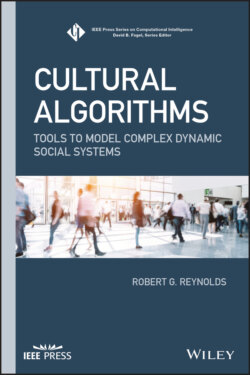Читать книгу Cultural Algorithms - Robert G. Reynolds - Страница 31
CAT Sample Runs: Other Problems
ОглавлениеIn addition to the ConesWorld system, the CAT System's optimization abilities can be used on a number of other optimization problems. As the ConesWorld system had two possible input variables with a single output across a relatively small dataset, it was possible to create a three‐dimensional visualization of the data to watch as the system located these optimal values. In these examples, a larger number of variables with wider ranges and finer variations exist, meaning that a visualization of this information in the method previous seen in ConesWorld would quickly become incomprehensible, as the system would attempt to generate images with more than three dimensions.
Despite being unable to visualize the data range, it is still possible to visualize the means in which the knowledge sources deal with the data they encounter. The additional optimization problems observed by the system include the designs of a Tension Spring, a Welded Beam, and a Pressure Vessel. Each problem sought to minimize the dimensions of a given structure to save on material and space, while still remaining within the constraints rendered necessary by factors, such as precision (for the shaping and rendering of parts) and safety (to reduce the likeliness of critical failure).
The Tension Spring example involves the minimized design of the spring as visualized in Figure 2.15. The four variables that describe the spring itself relate to the diameter of the wire (d), the diameter of the coil (D), and the number of coils in the spring (N). The mass of the spring can be equated as follows:
where
It can be seen in Figure 2.16 that each knowledge source yields new discoveries, which are then capitalized on by the other knowledge sources. The topographical fitness, the highly explorative knowledge source which searches across bold predictions, leads the system to higher bounds in the fifth generation, after which the situational knowledge source focuses on this latest achievement. While the other, more explorative knowledge sources continue to explore, the exploitative knowledge sources continue to refine, examining only those small variations. Notice that at approximately generation 75, while the explorative knowledge sources had dropped off in terms of new discoveries, the highly exploitative situational knowledge discovered a minor improvement to the arrangement of variables in the design of the tension spring.
Figure 2.15 The tension spring [1].
Source: Reproduced with permission of Elsevier.
Figure 2.16 The Knowledge Source fitnesses of the tension spring problem.
This concludes our discussion of the basic conesworld system. In chapters 3 through 5 that follow the system will be used as a vehicle to experiment with varying Cultural Algorithm configurations. The focus of these chapters will be on mechanisms by which knowledge is distributed throughout the population. These mechanisms will include majority voting (wisdom of the crowd, auctions, and games.
